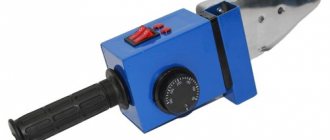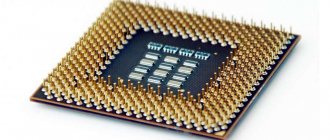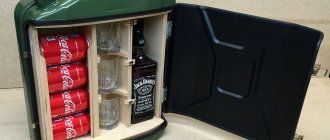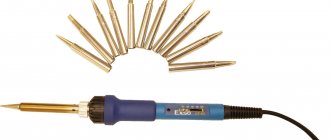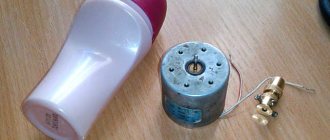Burner advantages
Working with a gas soldering iron is convenient and has a number of advantages:
- quick preparation. The soldering iron heats up in a short time, depending on the attachment used and rarely exceeding 30 seconds;
- Full autonomy of operation, without connection to the mains or generator;
- light weight and compactness of the tool;
- possibility of heating to a high temperature of 1500-2000 ℃;
- the ability to adjust the flame and, accordingly, the heating temperature.
Gas soldering irons are used by amateurs and professionals. A huge number of models are produced, many of which come with attachments.
Manufacturing from MLT and PEV resistors
A popular version of a homemade mini-soldering iron is using an MLT resistor (this abbreviation stands for “metallic, varnished, heat-resistant”). This is not even a mini, but a micro-device, but it heats up to 190°, which allows you to melt POS-60 solder.
To create it, in addition to the resistor itself, you will need:
- two insulated single-core copper wires;
- wooden block.
The resistor is the main part of the future device, and therefore its choice must be taken responsibly. It is better not to buy cheap Chinese products, but to give preference to domestically produced copper resistors.
To make such a mini-soldering iron, first the resistor is cleared of paint with some sharp object and the copper wire is protected. Then a loop is created from one end of the wire, freed from insulation, and placed on one of the edges of the resistor. And to the other edge they attach (ideally solder) the second end of the same wire.
Now you need to make a small twist from another copper wire to attach it to a wooden block (it will play the role of a handle here). The tip should protrude beyond the bar by no more than 1 centimeter, and the end of the resistor by no more than 2.5 centimeters.
They also make mini-soldering irons from a PEV-20 resistor (resistance 2 kOhm), inserting a copper wire tip into it, attaching a handle and wires. This mini-soldering iron can work from your home network. This is a very popular and simple design. The main thing in it is to make the copper rod correctly. For the tip, take either the rod of an old soldering iron or a piece of copper busbar.
From a ballpoint pen
You can make a mini soldering iron at home with your own hands using an ordinary ballpoint pen. But this, of course, is not the only material that will be needed.
The manufacturing process of such a mini-soldering iron also involves the use of an MLT resistor. The stem is cut off from it, and a hole with a diameter of 1 mm is drilled in the resulting cup.
A Soviet-made resistor (more precisely, in its ceramic casing) already has a ready-made through hole of approximately the same diameter, and it is into this that the copper tip of the soldering iron must be inserted.
At the next stage, you need to take the wire prepared in advance and bend it into a ring. Another important element in this design is a small rectangular PCB board. Wires need to be soldered to it, and a ring of wire should be soldered to the resistor. After this, the tip must be installed in the prepared hole.
Then the master must place an insulating pad around the heating parts of the future tool. For stable operation, their insulation must be reliable. And the wires, in turn, must have a temperature reserve so as not to overheat. And only after ensuring high-quality thermal insulation can the instrument be placed in the plastic body of a ballpoint pen.
Using such a device, it is quite possible to solder various microcircuits with a pitch of 0.5 mm or less. In this case, to work, as in the case of an ordinary soldering iron, you will need solder and flux. In addition, the tip of a homemade mini-soldering iron must be cleaned or replaced periodically.
Choosing the right tool
An attachment for a soldering iron for soldering small parts.
The choice depends on your priorities in work, because you can solder various parts, but at home they often deal with problems such as extending wires, soldering connectors, antennas, and electrical equipment.
For work in the country or at home, an electric soldering iron, which has a reasonable price, is well suited. It’s convenient that you can work with it for a long time. Its disadvantages:
- temperature is not regulated;
- the tip overheats;
- the presence of static electricity, which can damage soldering elements;
- short service life;
- poor insulation of the soldering iron tip.
A convenient and functional device is a gas soldering iron, the main advantage of which is that you can work anywhere, regardless of the presence of an outlet. Such a tool has a fairly high price, but it can solder everything you need.
A gas soldering iron is convenient to carry with you or carry in a car.
You can repair electrical equipment on the road when your car breaks down or fix an antenna on the roof of your house.
Gas tools are mobile; they operate from a canister filled with gas. You can use them as a gas burner. The price of the tool may vary. It depends on the manufacturer, type of flame, degree of protection, heating temperature.
The device of a gas soldering iron - Welding Profi
The procedure for soldering two metal parts was known to the ancient Greeks. Today, the word soldering iron is more associated with the creation or repair of equipment powered by electricity.
However, soldering irons are constantly used by jewelers, repairmen, and auto mechanics.
And if you imagined an auto mechanic trying to solder something with a household electric soldering iron, then you are deeply mistaken, they use a gas soldering iron .
Gas torches for soldering with a disposable cylinder: types, characteristics and technical features
A mini gas torch for soldering is an excellent alternative to a soldering iron; it is indispensable in places where there is no power supply.
The device is capable of operating from such types of gas as: propane-butane, isobutane, methyl acetylene propadiene (MAPP).
A propane soldering torch, unlike an electrically powered soldering iron, only takes three seconds to reach operating temperature.
Despite the fact that the price of a gas soldering torch is higher than its electric counterpart, it is lighter in weight and more compact. Depending on the number of disposable gas cylinders, the device can be used autonomously for a long time, even in the forest.
Gas burners for soldering with disposable cylinders can be equipped with ignition using a piezoelectric element and differ in design.
Basically, the burners are powered from replaceable cylinders, but they also work from stationary sources using adapters.
Such equipment is mainly used for soldering joints and sections of copper pipes and other metal products with a low melting point. The soldering process also uses acid and hard solder.
How does this type of soldering iron work? When the valve opens, gas enters the nozzle and is ignited by a piezoelectric element or an external fire source. By adjusting the valve, the flame is adjusted to a thin blue flame with a high temperature at the tip.
The maximum temperature with conventional gas reaches 1600˚C, and when using methyl acetylene propadiene (MAPP), the temperature can rise to 2400˚C. The standard nozzle is made of stainless steel with a tip made of brass or ceramic.
But there are nozzle attachments with a flexible base that allow you to change the direction of the flame.
Area of use
Gas equipment of this type is used for soldering copper products: connecting pipes, soldering small cracks, connecting copper cables in couplings, as well as for repairing circuit boards with various solders.
The burner can also be used to repair radiators, both automobile and other types. The function of a soldering iron is not all the capabilities of a gas device.
In plumbing, a torch is used to heat and loosen rusted bolts and other joints.
The temperature of the flame can be used to temper hard metal. But the device is most widely used in economic affairs.
If you prefer outdoor recreation, often go hiking, or are a hunter or fisherman, a soldering device will become indispensable in natural conditions. It makes it easy to light a fire, and in some cases even heat up food.
Hunters use a device for singeing a plucked bird or a small wild boar. But initially the designer developed the mini-torch as a device for soldering.
Types of gas soldering irons
The most common type of burner, which has low fusible properties, is used for household purposes, as well as in construction, where such a device replaces a construction hair dryer, but is independent of the electrical network. The disadvantage of such burners is an unstable flame, which manifests itself when the device is tilted or turned over during the working process. In more expensive burners, such manipulations do not affect the stability of the fire flow.
This type of torch is not used for soldering. Their main function is to ignite a fire or coals for a barbecue, as well as any heating that requires an open flame. Melting frozen sections of pipes, or warming up diesel engines, as well as disconnecting pipes on tow, heating and removing old paint and many other rough jobs.
Turbocharged soldering irons
Ejector soldering irons have a less broad focus, but their price is higher than tourist ones. Used by craftsmen for processing and manufacturing products from non-ferrous metals.
High temperature generation and flame control are well suited for hardening, metal soldering or other thermal applications where consistent high temperatures and a well-defined fire cone are required.
Depending on the specific application, burners and nozzles may differ.
A microgas lamp for soldering is used in repair and jewelry making, and given the absence of oxygen supply, it allows delicate work to be performed delicately.
Torches with large nozzles and high power are well suited to industries such as artistic forging, precision bending or iron stamping. This particular tool is used by home craftsmen as a base for gas forges and hardening furnaces made with their own hands.
Despite possible periodic flashes of gas in ejector soldering irons, in the core itself, the temperature remains relatively stable.
The gas preheating circuit makes the device economical, allows you to quickly reach operating power and more accurately control the temperature.
High temperature gas soldering iron
In this type of gas burner, instead of the usual propane-butane cocktail, MAPP (methyl acetylene propadiene) gas is used as fuel, and the flame temperature reaches 2200-2400˚C.
Almost all the energy is concentrated in a stable cone with a pronounced boundary. Used for heating, forging and bending hard steels with a high carbon content, as well as three-dimensional parts.
The produced qualities help to withstand the technology of hardening and tempering of metal.
MAPP gas torches are capable of soldering and welding stainless steel without overheating even the thinnest parts. MAPP gas has a low boiling point, which makes it possible to use the burner at a temperature of -20 °C, even without a gas heating circuit.
Characteristics of gas burners
Considering that the concept of a gas lamp presupposes several types of devices, their parameters are completely different, and only a small part of the technical capabilities will be similar.
Frequent parameters on which the user's choice is based:
- Battery life on one cylinder
- Is there an air leak?
- Nozzle material and length
- Type of connection and type of cylinder
- Possibility of flame adjustment
- Limit flame temperature
- One-handed operation
- Presence of piezo ignition
Technical features of gas burners
- Flame power - this parameter depends on the type of work to be done. In order to desolder electronic components, minimum power is required, but when heating metal for bending or forging, maximum power is required.
- Torch shape - if you use a flame for heat-shrinking work, or flame processing of large areas, a wide torch is used, but for soldering a clearly defined flame in the form of a needle is used.
- Case material - a plastic case is a budget option, unlike a metal one. But when the nozzle is heated to maximum temperatures and used for a long time in this mode, the plastic may melt.
- Flame stability - if the housing angle changes to 45˚ or more, the flame does not go out, but allows you to work in any chosen position.
- Availability of replaceable nozzles - this equipment is mainly relevant for a soldering iron torch. The delivery set includes nozzles that perform a particular task.
- Special requirements - these features are taken into account when choosing a tourist model, namely: the shape of the burner, the stability of the structure, heating a specific volume of liquid in a certain period of time, the presence of wind protection.
USB soldering iron
A DIY USB soldering iron can be connected to any Power Bank device - it’s very convenient.
To make a soldering iron with a USB plug, you must first take a copper wire with a millimeter diameter and use pliers to make a ring at one of the ends. The ring must be large enough for the bolt to fit through it.
Then you need to take a nichrome wire 7 cm long and wind several spirals onto a copper rod on the side where there is no ring (closer to the end, but not at the very end - this is important!)
It is worth paying special attention that the copper rod and nichrome wire must be insulated from each other, for example, with fiberglass. Next, the copper wire should be attached to a suitable size bar with a bolt
In the next step, two copper wires are screwed to a nichrome wire, the switch is glued to the bar, and the wires are soldered to the switch. Then you need to wrap the lower part of the bar with electrical tape - this is how the wires of the mini soldering iron are fixed
Next, the copper wire should be attached to a suitable size bar with a bolt. In the next step, two copper wires are screwed to a nichrome wire, the switch is glued to the bar, and the wires are soldered to the switch. Then you need to wrap the lower part of the bar with electrical tape - this is how the mini-soldering iron wires are fixed.
Finally, a USB plug with a wire of a certain length is taken and connected to the copper wires. Polarity is not important in this case. Before heat shrinking, those areas where the wires are connected to each other must also be insulated.
In addition to this, you should also tape the wire from the USB to the bar with electrical tape. After this, the performance of the soldering iron can already be checked on some workpiece.
Propane mini gas burner
A DIY propane gas burner is quite easy to make.
To make a homemade burner you will need the following materials:
- brass tubes of various diameters;
- plates made of some heat-resistant material (you can use wooden blocks);
- sealing material - silicone or fluoroplastic (FUM tape).
You will also need some tools:
- vice;
- drill;
- chuck for small diameter drills, for example from Dremel.
To connect the burner to a liquefied gas cylinder you will need a reducer and a rubber hose.
Structural parts and gas used
A gas soldering iron consists of a gas reservoir and a burner on which a soldering nozzle or tip can be installed. Gas soldering can be carried out either using heated air, when only a torch is used, or when using a nozzle.
The gas reservoir can be replaceable and connected to the burner using a hose, or it can be portable, made in the same design as the burner and refilled from a cylinder, which are often used for refilling lighters.
The latter design is more common and preferable for domestic use because of its compactness and high mobility.
But in production shops, and especially in car repair shops, you can also see large gas soldering irons running on propane coming from 50-liter cylinders.
Various gases are used for operation: propane, butane or a mixture of gases - mapp gas. The latter contains methyl acetylene, propadiene and propane in a certain proportion.
Mapp gas is very effective due to its combustion temperature reaching almost 3000℃. But the main advantage is that with the same performance of a gas soldering iron, it will be required eight to ten times less in volume than acetylene.
Nuances and operating instructions
A propane burner is a dangerous device, and therefore, when working with it, you must follow the operating and fire safety rules
Roofing propane burner, instructions for use:
Carefully and tightly screw the nozzle onto the nozzle. Connect a hose to the cutter fitting, securing it with a special clamp. They are usually not included in the kit and will need to be purchased separately. Attach the second end of the hose to the gas vessel. Check the tightness and reliability of the connections with the flame regulator closed. Using soapy water, check the tightness of the connection and gas-air leaks, and with the gas valve on the cylinder open. Smoothly turn the gas regulator counterclockwise and light the burner. It is prohibited to point the torch at flammable materials. After completing the work, close your gas valve on the vessel. When the burner flame goes out, close the torch torch regulator and allow it to cool.
It is prohibited to point the torch at flammable materials. After completing the work, close your gas valve on the vessel. When the burner flame goes out, close the torch torch regulator and allow it to cool.
Dangerous and harmful production factors when working on the roof with a propane torch:
- The occurrence of a fire hazard;
- explosion of a gas container;
- burns from open fire;
- thermal burn from heated cutter surfaces.
Structure and principle of operation
Soldering irons have an extremely simple structure: a copper rod that interacts with a heating element is placed in a kind of tube that acts as a housing. A heat-resistant power wire is connected to the heater. And the whole structure is completed by a handle made of a material with low thermal conductivity.
Under the influence of electric current, a heating element (for example, a nichrome spiral) transfers thermal energy to a copper rod called a tip. The tip, having high thermal conductivity, heats up, which allows soldering.
https://youtube.com/watch?v=yFHqd2w1ZE0
Soldering iron with a resistor as a heating element
An interesting design can be implemented using a powerful resistor. With its help, you can make a soldering iron with your own hands. To assemble such a device you will need the following parts:
- Resistor of the PEV series, designed for power up to 10 W, with a rating of 15 to 27 Ohms. It should be taken into account that it will be connected to a 12V or 24V network.
- Copper rod. It will act as a soldering iron tip. It should be taken into account that the outer diameter of the rod must correspond to the inner diameter of the resistor hole. The rod should fit tightly in this hole. You can provide a hole into which a bolt will be screwed to secure the rod.
- A ready-made spiral, which is present in the resistor, is used as a heating element. It is designed for a specific resistance and will provide the necessary dissipation power.
- Power cord with plug.
- Handle for attaching the resistor. It must be made of dielectric material and have high thermal insulating properties. In addition, for convenient operation, the handle must be given an ergonomically sound shape.
If such a device is planned to be used to solve a wide range of problems, it is advisable to connect it to a power regulator.
Work to improve flame control
Burners with adjustable flame power
To ensure normal operation of our burner, it is necessary to equip it with a divider and a tap. A suitable place to mount the tap is near the handle, 2–4 cm higher. But it can also be installed on the supply pipe. A faucet from a burner from an old autogenous engine or its other analogue will do. It is permanently fixed to the tube with a threaded connection. To seal the connection, use FUM tape.
The divider will be installed on the pipe with the nozzle. It also needs to be made of brass Ø 15 mm. The best option is a cylindrical part with a hole for a tube with a nozzle. If there is none, do the following:
- Take a brass pipe Ø 35 mm and cut a piece of 100–150 mm.
- Stepping back from the end, use a marker to mark 3-5 points exactly distant from each other.
- Drill 8–10 mm holes in it with a drill and use a grinder to make even cuts to them.
- Now you can bend everything to the center and weld it to the burner tube.
Burner nozzle device
To properly secure the divider, it must be placed so that the nozzle protrudes 2-3 mm from the connection point. Thanks to this device, two goals can be achieved: to protect the flame from strong winds and to provide it with a flow of oxygen, which is necessary for a more stable and strong flame.
All welding points can be smoothed using a grinder. Then your homemade burner will look more solid. That's all. Now all that remains is to supply gas and use the burner for its intended purpose.
Nuances and operating instructions
A propane burner is a dangerous device, and therefore, when working with it, you must follow the operating and fire safety rules
Roofing propane burner, instructions for use:
Carefully and tightly screw the nozzle onto the nozzle. Connect a hose to the cutter fitting, securing it with a special clamp.
They are usually not included in the kit and will need to be purchased separately. Attach the second end of the hose to the gas vessel. Check the tightness and reliability of the connections with the flame regulator closed. Using soapy water, check the tightness of the connection and gas-air leaks, and with the gas valve on the cylinder open. Smoothly turn the gas regulator counterclockwise and light the burner.
It is prohibited to point the torch at flammable materials. After completing the work, close your gas valve on the vessel. When the burner flame goes out, close the torch torch regulator and allow it to cool.
Dangerous and harmful production factors when working on the roof with a propane torch:
- The occurrence of a fire hazard;
- explosion of a gas container;
- burns from open fire;
- thermal burn from heated cutter surfaces.
Using a lighter
This mini soldering iron can be assembled in no time. It will be based on a gas lighter with a piezoelectric element; you will also need masking tape and thick copper wire (its thickness should be from 1 to 3 mm).
Creating a mini-soldering iron in this case begins by wrapping wire around a pencil or other similar object. It is necessary to make 5 turns in a row, after which you can pull out the pencil.
Next, on the convenient side, about two centimeters from the turns, the wire is bent so as to form a right angle. On the other hand, at the same distance from the turns, the wire is simply cut off.
The straight end of the resulting copper element must be processed, say, with sandpaper, so that it is sharp, like a needle. This end will be the tip of a homemade mini-soldering iron.
Then you need to try on how this wire will be combined with the lighter. The end of the wire in the form of a right angle should be located below, and the coiled part together with the sting should be located directly above the hole from which the flame comes out.
Now you need to insulate the lighter with tape, that is, wrap it at the point of attachment to the wire 5 to 7 times.
Then the wire is installed in its place and the entire structure is again wrapped with tape. Ready! A mini-soldering iron made from a regular lighter is good because it does not require connection to batteries or an electrical outlet.
For soldering with such a mini-soldering iron, it is better to choose tubular solder with flux in the core. And during operation, you should not keep the lighter in the burning mode for more than five seconds, otherwise the internal pressure mechanism may melt.
How to make a soldering iron with your own hands: 4 different ways
Making a small electric soldering iron at home is not particularly difficult. A soldering iron is a very necessary and useful tool for all home craftsmen who love crafts and DIY things. Of course, such a device can be purchased at an electrical goods store, but it costs money. Masters of their craft can try to make such a tool on their own, especially if the work requires a specific unit.
The first soldering iron was invented by Ernst Sachs in 1921. He also patented a hammer tool for tin work.
To make an electric soldering iron, we do not need a huge amount of available tools and materials.
The inside of the soldering iron is simple and consists of the following components:
- Metal tube with handle and sting;
- An electrically insulated heating element (the insulation can be mica or ceramics);
- A current-carrying cord connected to a network or transformer.
Basically, electric soldering irons operate on mains power, a transformer, or batteries. There are types that have a built-in gas burner or conventional external heating.
A low-power electric soldering iron is used for soldering electronic parts and microcircuits, and a powerful one is used for massive, large parts.
- Nichrome - have a nichrome wire spiral that passes current;
- Ceramic - consists of ceramics, heats up quickly, but, unfortunately, such a heater is very difficult to repair after a breakdown;
- Induction – heating occurs using an induction coil;
- Pulse (spot) – works in the mode of pressing and holding the start button;
- Gas – stand-alone cordless soldering iron that can be used anywhere;
- Battery - this type is usually low-voltage, having low power (usually about 12 v or 15);
- Infrared – heated by infrared radiation with a wavelength of 2-10 microns;
- Ultrasonic – used where it is difficult to solder aluminum using conventional methods;
- A soldering iron heated over an open fire is a fairly simple device that sometimes replaces a high-power device.
The most common are network devices powered from a 220V network. Sometimes, when assembling industrial electrical appliances, an entire soldering station is used, with which you can use additional capabilities.
It is also worth noting a blowtorch, in which heat is released when flammable substances burn. It is used to heat elements, melt solder and warm up other soldering irons.
Features of a homemade soldering iron
You can make tools of different power with your own hands. The choice of a specific option depends on what you plan to solder. After all, a low-power device will not heat the soldering parts to the required temperature, and using a powerful soldering iron can lead to overheating.
The main advantage of a homemade mini soldering iron is the opportunity to save on purchasing a factory-assembled product. Small work can be carried out with a device assembled by yourself.
What can you make a mini soldering iron from? This could be a resistor, a ballpoint pen, a gas lighter, etc. improvised materials.
Types of soldering irons and soldering rules
Soldering is the process of obtaining a permanent connection, which is obtained using a special tool - a soldering iron.
Soldering irons can be electric, induction, pulse, or gas. The easiest way to do soldering is to use a screwdriver heated with gas, but this is not very effective because the screwdriver cools down quickly.
Another version of the tool is a copper bar, which has a point on one side and is mounted on a rod with a handle on the other. The tool is heated on a gas stove or with a blowtorch.
Depending on what you will be soldering, different types of soldering irons are used. If the amount of work is large, then it is better to use an electric soldering iron, and a gas tool is perfect for soldering in difficult conditions where there is no electricity or it is turned off.
Before starting work, read these simple rules to get a good result:
- surfaces must be well cleaned;
- they must have a tight connection;
- During work, the elements to be connected must be heated to the required temperature.
To insulate the soldering area, use electrical tape or a special tube, which is slightly heated and fixed.
